Explore the most popular types of New England Style Homes, from cozy cabins to elegant coastal retreats that add to the region’s charm.
Diving into the vast world of interior design, I’ve often hit a crossroads. Why box our decor into a single category when our tastes, as complex as our personalities, crave variety? My journey in decorating is a living testament to this belief, always evolving, never confined to just “farmhouse” or any singular theme.
I have a soft spot for farmhouse charm, coastal views, and cottage coziness, blending them with touches of primitive, traditional, and rustic elements. In our new coastal cape cod-style home, my fascination with the Gilded Age’s elegance has become a surprising centerpiece. Yet, this seemingly odd piece of the puzzle fits perfectly within the New England backdrop I call home. Here, the architectural beauty and diverse landscapes embrace the eclectic, making what seemed like a mismatched decor find its rhythm in the rich melody of “New England Style.”
This exploration of architectural styles, from farmhouse simplicity to Gilded Age grandeur, has shaped my style and inspired this post. Let’s explore the characteristics of New England style homes together. From Maine’s coasts to Vermont’s cabins, we’ll uncover how to bring New England’s architectural charm into our spaces, celebrating its unique beauty.
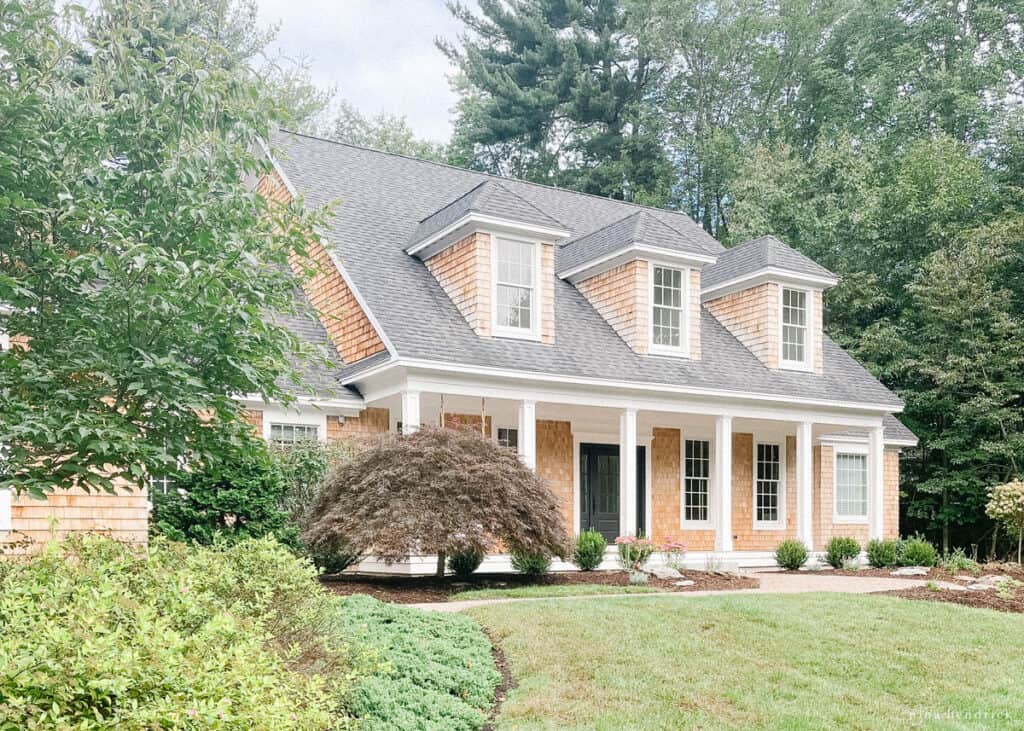
1. Coastal New England Style Homes
Embracing shingle-style architecture is akin to weaving the very essence of the New England coast into the fabric of our homes. This distinctive style, characterized by cedar shakes, gabled roofs, and a deep connection to the surrounding landscape, captures the heart of coastal living. It reflects a harmony between the rugged beauty of the Northeast shoreline and the architectural tradition that has defined this region for generations.

I’ve always drawn inspiration from the rugged beauty of the weather-beaten coast, its stoic lighthouses standing guard over the salty cedar shingles. Now, living in a coastal-style cedar shake Cape Cod home in the Seacoast region of New Hampshire, my connection to these landscapes has only deepened. The charm of Nantucket, with its welcoming Adirondack chairs, lush gardens, and striking hydrangeas, the size of dinner plates, continues to influence my yard choices, embodying the essence of coastal living. The allure of Ogunquit, Maine, with its rocky cliffs, crystal blue waters, stunning homes, and the picturesque Perkin’s Cove, captivates me still. These places, along with the serene beauty of my New Hampshire surroundings, are what I envision when I weave shades of blue, both navy and lighter hues, into my home, creating a space that resonates with the tranquility and unique beauty of these coastal regions.
For those who are charmed by this aesthetic, you might find my article on “coastal grandmother style” particularly fun. It delves deeper into how to achieve a cozy, timeless look that evokes the spirit of New England’s seaside elegance in your own home and wardrobe!
Adding New England Coastal Style
- Opt for Cedar Shake Shingles: Choose cedar shingles for their natural weathering to a silver-gray, capturing the quintessential coastal look while providing durability against the elements.
- Incorporate Architectural Additions: Enhance your home’s outline with classic New England architecture such as gabled roofs, a “widow’s walk,” or a tower, to add a distinctive coastal silhouette.
- Use White Trim for Contrast: Apply white trim around windows and doors against cedar shingles to highlight your home’s architectural details, embodying a fresh coastal aesthetic.
- Select Outdoor White Furniture: Brighten your outdoor spaces with white furniture, creating inviting areas for relaxation that reflect the seaside’s light and airy feel.
- Plant Abundant Hydrangea Gardens: Introduce hydrangeas to your garden to bring in vibrant colors and a touch of the coastal landscape, enhancing the natural beauty around your home.
- Incorporate Shades of Blue: Integrate shades of blue, from navy to sky, in your interior decor to echo the ocean’s vast palette, adding tranquility and depth to your living spaces.
via Sootheby’s Realty
2. Farmhouse
“Modern farmhouse” has been all the rage in recent years, but here in New England, the word “farmhouse” tells a different story than perhaps it might in other places. Around here, the idea of endless fields stretching out from a grand front porch isn’t always our reality. Our ancestors generally worked smaller patches of land, their homes nestled close together, a testament to their unity in taming this wild, rocky terrain. They poured their hearts into the soil, hoping to feed their families and, on a good year, share the fruits of their labor with their parish.
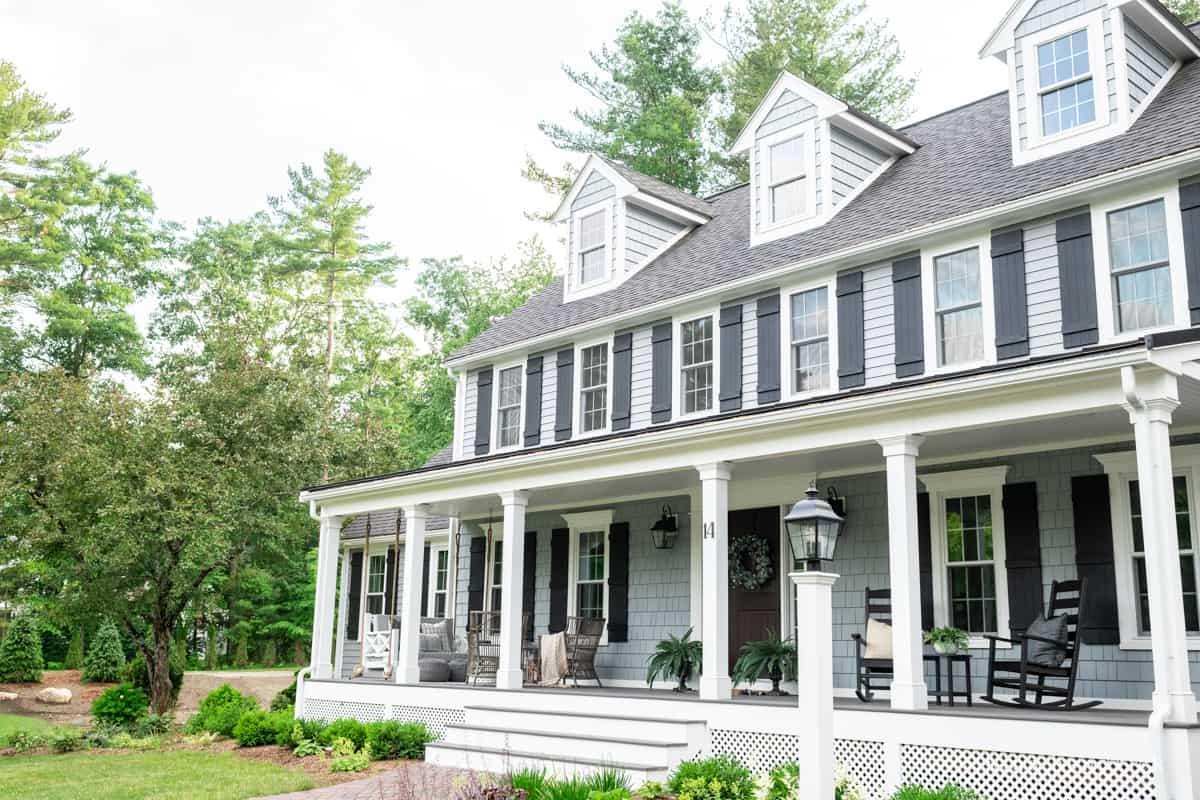
There are moments when I catch myself dreaming of that big, airy farmhouse, with its tall ceilings, open floor plan, and wide porches set on acres of open land. Yet, our previous home, a cozy Massachusetts center hall colonial snug among neighbors, probably paints a more accurate picture of the traditional “New England Farmhouse” style.
What sold us on our former neighborhood wasn’t just the charm of our own home but the historic colonial homes with their timeless barns that melded so beautifully with the newer houses around them. And there’s nothing quite like a stone wall in your backyard to make it truly feel like quintessential New England. These farmhouses inspired the feel of our own renovations, including a farmer’s porch. What could have become a stuffy and cookie cutter colonial style MA home we instead transformed into a cozy and approachable New England farmhouse.
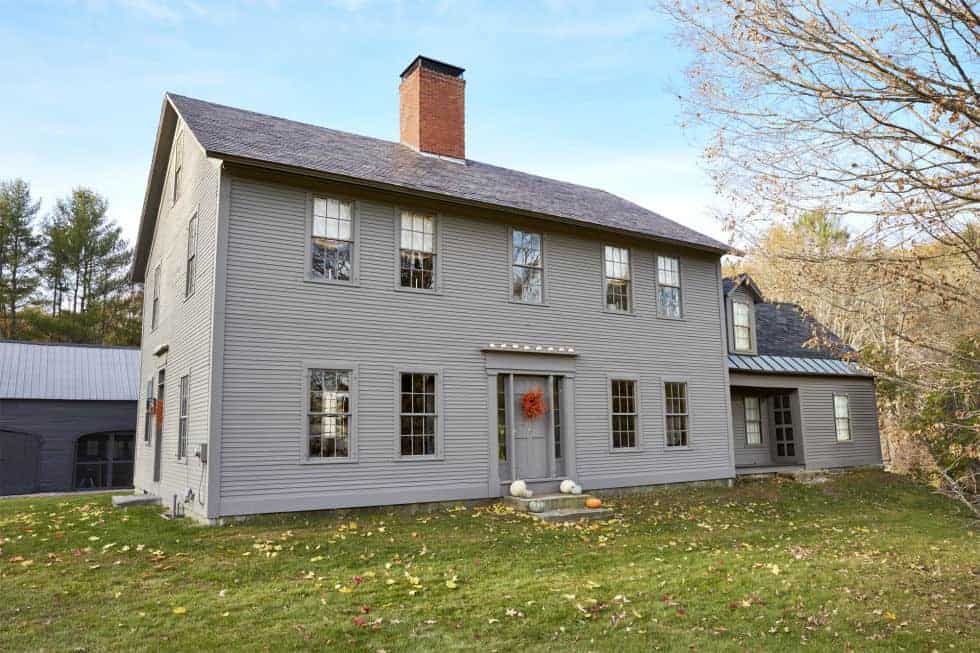
via Country Living
And then there’s New Hampshire, my beloved home state, where both sides of my family have lived in historic farmhouses that could fill storybooks. These homes, with their treasure troves of antiques, spooky barns, and old stone walls, were the playscapes of my childhood. Even though those old New England homes have since passed out of our family, their memory has seeped into my soul, influencing my style more than anything else. It’s a connection to the land and to my roots that I cherish deeply.
Adding New England farmhouse Style
- Embrace Practical Architecture: When designing or updating your home, incorporate elements that reflect the simplicity and functionality of farmhouse living, ensuring spaces are both practical and comfortable.
- Create Cozy Spaces: Aim for smaller, cozy room layouts that maximize warmth and intimacy. Consider lower ceilings and snug arrangements to enhance the farmhouse feel.
- Feature a Central Hearth or Fireplace: Make the fireplace a focal point in your living space, symbolizing the warmth and communal spirit of farmhouse living.
- Incorporate Barns and Outbuildings: If space allows, add structures like barns or sheds to echo the farmhouse’s agricultural heritage, useful for storage or as unique living spaces.
- Cultivate Gardens and Greenery: Introduce a kitchen garden or container plants to bring elements of self-sufficiency and nature into your home, regardless of yard size.
- Utilize Stone Walls: Add stone wall features, either as garden boundaries or decorative elements, to capture the historical charm and practicality of New England farmhouses.
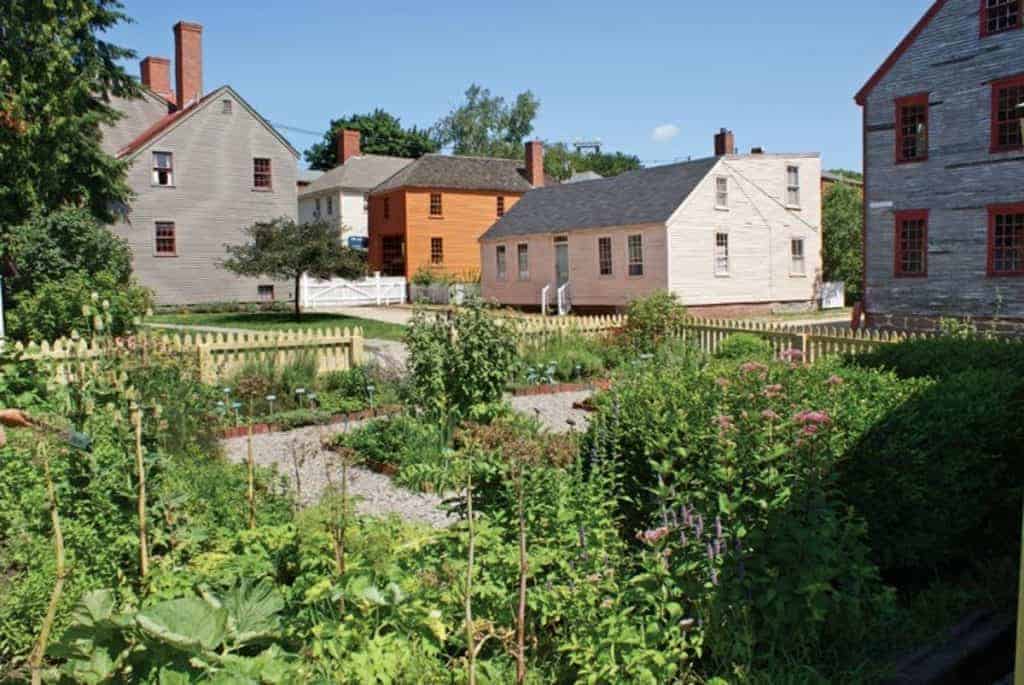
Strawbery Banke via Old House Journal
3. Early American (Primitive) Style: A Nod to New England’s Puritan Roots
The Early American, or Primitive (“Prim”), style is a direct nod to the austere, functional aesthetic of the 17th century Puritan communities in New England. It’s seen as a precursor to the more developed New England Farmhouse style, emphasizing simplicity and the essentials of life.
My childhood home, a reproduction antique saltbox center chimney colonial, perfectly captures this primitive aesthetic. With its beautiful wood beams and tongue-and-groove ceilings, it echoes the architectural spirit of the earliest homes in America in places like Plymouth, Salem, Sturbridge, and Strawbery Banke.
Adding early American (primitive) Style
- Incorporate Simple, Functional Furniture: Choose furniture that reflects the Early American emphasis on simplicity and functionality. Look for pieces with clean lines and minimal ornamentation, such as Shaker-style chairs and tables.
- Center Chimney & Brick Hearths: The center chimney is a classic New England staple, with brick hearths or wood stoves as the hub of the home.
- Natural Materials: Use wooden beams and hardwood floors to create a cohesive look that highlights the raw beauty and simplicity of Early American design.
- Select Muted, Earthy Color Palettes: Decorate with muted colors inspired by the natural landscape, such as sage greens, earthy browns, mustard yellows, and soft blues. These colors create a warm, welcoming environment that reflects the era’s simplicity.
- Decorate with Handcrafted Items: Decorative elements should have a handcrafted, artisanal quality. Look for handmade quilts, pottery, and folk art that add a personal, cozy touch to your space.
- Highlight Historical Details: Incorporate architectural and decorative details that nod to the period, like wrought iron hardware, wooden shutters, and paneled walls, to enhance the historical feel.
FAQs about New England House Styles
Q: What does New England style mean?
A: New England style means an approach to design and architecture that reflects the historical and cultural heritage of the New England region of the United States. It’s known for its emphasis on classic aesthetics, comfort, and functionality, blending elements like wood and stone, colonial furnishings, and maritime decor to create cozy, inviting spaces.
Q: What is a New Englander house style?
A: The New Englander house style is an informally recognized architectural style that came into prominence in the late 19th century, appreciated for its practical design and unassuming elegance. Characterized by a layout featuring a staircase directly facing the entrance to maximize interior space, these homes typically present a symmetrical facade, complemented by a pitched or gabled roof and a central chimney, showcasing the enduring architectural traditions of New England. Notably, New Englander homes often extend backward, creating a longer, narrow shape that adds living space while retaining a modest front appearance. This extension strategy is emblematic of the style’s emphasis on functional, efficient use of space. Many New Englander homes also include a front porch, adding to their charm and providing a welcoming outdoor space for relaxation and community. Finished with clapboard siding and simple trim around windows and doors, the New Englander house style embodies the region’s fondness for practical beauty and historical resonance. Here’s an example with interesting comments!
Q: What were the types of housing in the New England colonies?
A: In the New England colonies, housing types varied from simple, one-room cottages to more elaborate Georgian and Federal style homes as the colonies grew wealthier. Early homes were often constructed with wood, featuring steep roofs, central chimneys, and small windows. The Cape Cod-style homes, with their simple, symmetric design, were also common.
Q: What is the most popular style home in New England?
A: The most popular style home in New England is arguably the Colonial style, known for its symmetry, central front door, gabled roof, and double-hung windows. This style’s enduring popularity stems from its historical roots in the region and its adaptability to modern living while maintaining its classic charm.
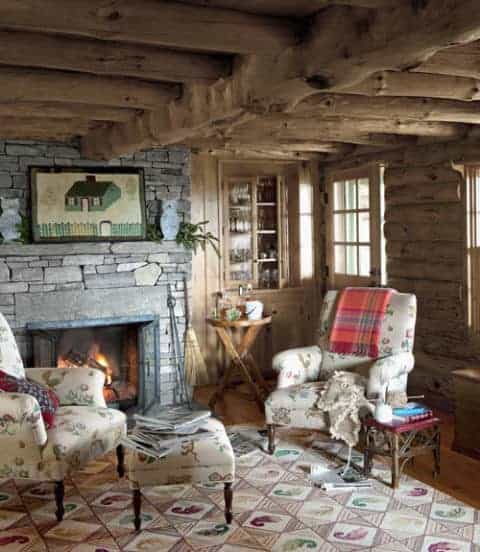
4. Rustic Style: Embracing the Warmth of New England’s Mountains
The Rustic style is a quintessential element of New England’s aesthetic, especially prominent in mountain homes and ski cabins. It’s characterized by a hearty embrace of natural materials and textures that reflect the rugged beauty of the outdoors. While I will admit I don’t gravitate toward this style, its warmth and earthiness hold undeniable appeal for many, especially in settings like cozy mountain retreats.
Adding New England Rustic Style
- Natural Wood Elements: Embrace unfinished or reclaimed wood for structural features and decor to introduce warmth and texture.
- Robust, Natural Fabrics: Choose wool, burlap, and leather for furnishings and textiles, adding depth and comfort.
- Stone Features: Add stone in fireplaces, walls, or floors to connect with nature and complement wood accents.
- Neutral, Earthy Palette: Use browns, greens, grays, and beiges to create a serene, nature-inspired environment.
- Vintage or Handmade Accessories: Incorporate items with a story, like antiques or crafts, to add character and authenticity.
- Large Windows: Install big windows to maximize natural light and outdoor views, blending indoor and outdoor spaces.
- Cozy Lighting: Opt for soft, warm lighting with lamps, lanterns, and candles to enhance the rustic atmosphere.
- Animal Motifs: Integrate decor featuring deer, bears, fish, and other wildlife to strengthen the connection with nature.
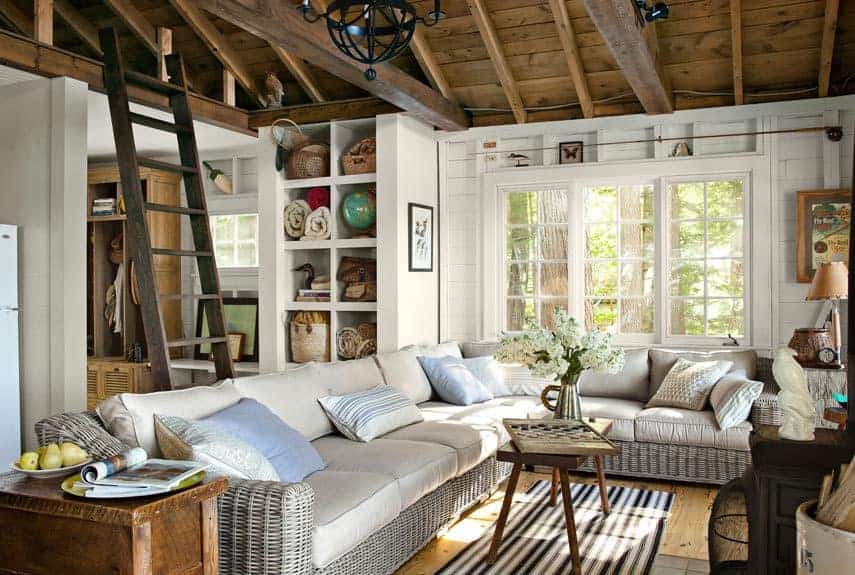
5. Cottage
The rugged Maine coast may inspire me, but the Lakes Region of New Hampshire is my home. The New England Lake Cottage style embodies a harmonious blend of the diverse styles I cherish: a testament to the rich tapestry of my family’s heritage and my own aesthetic leanings. This style resonates deeply with me, thanks in large part to my grandparents’ A-frame lake cottage—affectionately known as “The Cottage”—and Mack’s family legacy rooted in the century-old history of “Camp.”
Cottages and camps are quintessential to the New England lifestyle. Unfortunately (but understandably), they’re becoming rarer, often replaced by larger, more modern and energy-efficient homes. Despite their humble beginnings and lack of winterization, there’s a certain charm in updated cottages, especially those with their interiors painted a refreshing white, that I simply can’t resist.
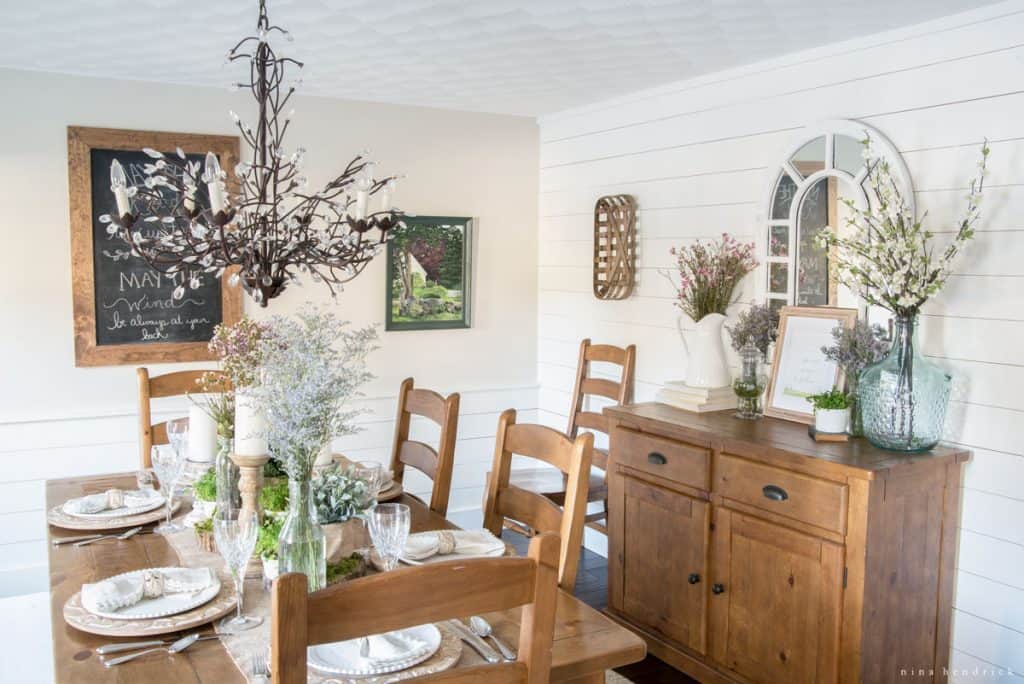
In our homes, the presence of planking, board-and-batten, and the choice of light, airy colors are direct nods to this beloved style. It’s a homage to the cottage aesthetic, blending the simplicity and warmth of lakeside living with a bright, welcoming ambiance.
Adding New England cottage Style
- Whitewashed Wood: Utilize whitewashed or painted wood for walls, floors, and furniture to brighten spaces and create an airy, cottage feel.
- Soft, Light Fabrics: Choose light, breezy fabrics for curtains, upholstery, and linens to enhance the light-filled, casual ambiance.
- Charming Floral and Plaid Patterns: Incorporate floral and plaid patterns in textiles and wallpapers for a traditional cottage aesthetic.
- Vintage and Handmade Decor: Add vintage finds, handmade items, and rustic accents to imbue spaces with character and a sense of history.
- Cozy Nooks and Crannies: Designate areas for reading or relaxation to emphasize the cozy comfort that cottages are known for.
- Garden Connections: Embrace cottage gardens with abundant flowers and plants, linking indoor spaces with the natural beauty outdoors.
- Nautical or Lake-Inspired Accents: Include lake or nautical-themed decor like paddles, lanterns, and rope accents to nod to the cottage’s waterside heritage.
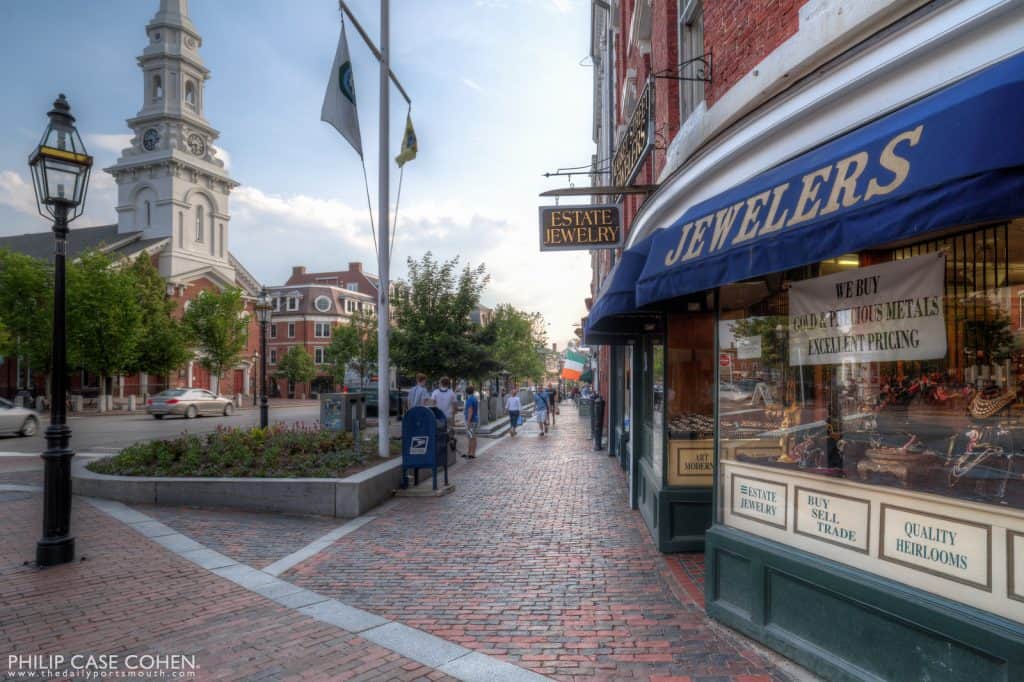
6. Seaport Style
Seaport Style: Celebrating New England’s Coastal Legacy
Seaport Style is deeply rooted in the unique charm and maritime heritage of New England’s historic port cities, with Portsmouth, New Hampshire, standing as my beloved favorite. This style distinctively moves away from the broad coastal design often seen in expansive seaside homes, drawing instead from the rich tapestry of urban maritime life found in Portsmouth, as well as Newport, Boston, Newburyport, and Portland (among others).
Characterized by its brick and cobblestone streets, brick facades, and waterfront ambiance, Seaport Style embodies the intersection of maritime history and urban elegance. Portsmouth, in particular, serves as a vibrant showcase of this style, blending its significant historical roots with a lively, modern ethos.
Adding New England seaport Style
- Maritime Colors: Embrace a palette of navy, white, and grey, echoing the sea and sky for a coastal ambiance.
- Nautical Decor: Feature maritime symbols like anchors, ship wheels, and navigational instruments to celebrate seafaring heritage.
- Brick Elements: Use exposed brick walls or brick accents in flooring and pathways to capture the historic architecture of seaport towns.
- Cast Iron and Dark Metals: Opt for fixtures and hardware in cast iron, brass, or dark metal to reflect the durable, maritime industry.
- Rope Accents: Incorporate rope in railings, mirror frames, or decorative knots for a nautical touch.
- Reclaimed Wood: Introduce furniture or decor made from reclaimed wood, reminiscent of weathered docks and ships.
- Historic Lighting: Choose lantern-style lights inspired by old ship lanterns or portside lighting for authenticity.
- Ocean Artwork and Maps: Adorn spaces with maritime art, vintage nautical charts, and seascapes, celebrating ocean exploration and beauty.
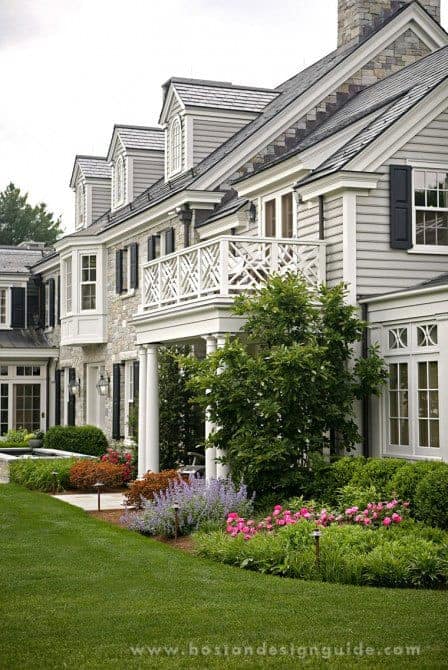
7. Traditional
New England Traditional Style: A Modern Take on Classic Elegance
New England Traditional Style masterfully merges the region’s rich history with the modern and vibrant “Trad” and “Prep” styles, transforming its historical elegance into a dynamic and accessible charm. Moving beyond its origins marked by stuffy patterned furniture, heavy wood finishes, and paneling, this style now adopts a fresher, more current approach. It infuses spaces with fun patterns, lighter finishes, and a mix of textures, rejuvenating classic design principles with a modern twist.
This evolution represents more than just a nod to the past; it’s a spirited reinterpretation that injects playful textiles and modern sensibilities into timeless design. Embracing both New England’s heritage and a contemporary lifestyle, the updated New England Traditional Style is a testament to understated elegance, re-envisioned to celebrate tradition with a joyful, modern flair.
Adding New England traditional Style
- Architectural Details: Enhance spaces with classic elements like crown moldings, wainscoting, and built-in cabinetry, adding historical depth with a refined touch.
- Hardwood Floors: Ground your interiors with the natural beauty of hardwood floors, a cornerstone of New England’s aesthetic that brings warmth and texture.
- Bright, Subdued Color Schemes: Choose a palette inspired by the outdoors, with earth tones, soft blues, and muted greens, now brightened with playful patterns and accents for a contemporary twist.
- Elegant, Functional Furnishings: Select pieces that balance traditional craftsmanship and comfort, updating heavy wood finishes with lighter woods or painted finishes for a fresher look.
- Symmetry: Maintain balance and harmony with symmetrical furniture arrangements, infusing spaces with an orderly elegance that’s both classic and inviting.
- Modern “Trad” and “Prep” Accents: Infuse lighthearted “Trad” and “Prep” influences through preppy patterns, tartan throws, and collegiate-inspired decor, adding a whimsical yet sophisticated flair to traditional settings.
- Update Colonial Inspirations: While embracing elements of classic colonial exteriors, such as a portico, Palladian windows, pediments, and dormers, modernize with bright white millwork and paneling to keep spaces airy and light.
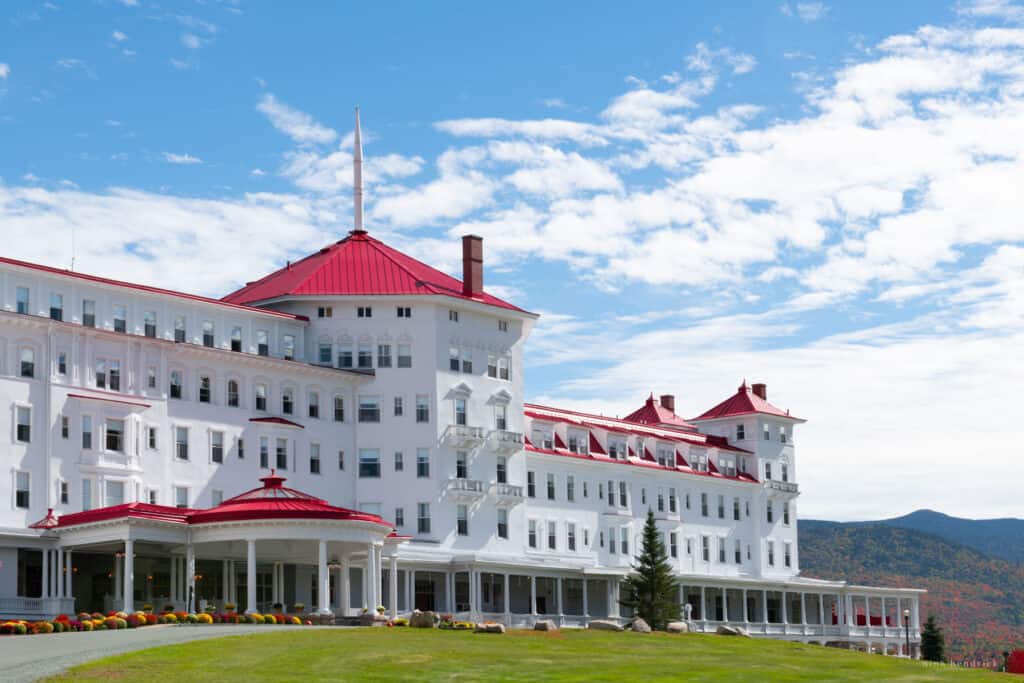
Gilded Age New England Style
Gilded Age New England Style embodies the pinnacle of architectural elegance and opulence from the late 19th to early 20th centuries—a period marked by rapid industrialization and the emergence of a wealthy class. This era’s iconic New England landmarks, such as the Omni Mount Washington Hotel, Wentworth by the Sea, the Newport Mansions in Rhode Island, and the enchanting Castle in the Clouds (Lucknow), serve as testaments to the era’s luxurious lifestyle and architectural grandeur. Today, elements of this style, like brass hardware, intricate wallpapers, and lavish materials, are on trend, yet the essence of Gilded Age design remains timeless.
Adding gilded age New England Style
- European Architectural Influences: Embrace the grandeur of Renaissance, Gothic Revival, and Beaux-Arts styles by incorporating elaborate architectural details such as turrets, gables, and ornamental carvings, bringing a touch of European elegance into your home.
- Expansive Estates & Landscaped Grounds: Create your own slice of luxury with well-designed gardens, reflecting pools, and grand entrances that echo the opulent outdoor spaces of Gilded Age estates.
- Opulent Materials and Finishes: Integrate luxurious materials like marble, mahogany, and gold leaf into your interiors, along with modern trends like brass fixtures, to add layers of sophistication and historical richness.
- Innovative Amenities: Blend contemporary comforts with luxury, inspired by the era’s technological advancements, to achieve a living space that is both opulent and functional.
- Art and Craftsmanship: Select decor and furnishings that highlight detailed woodwork, stained glass, and artisanal craftsmanship, celebrating the period’s dedication to bespoke artistry and quality.
- Panoramic Views and Strategic Locations: Arrange your living spaces to feature natural vistas or thoughtfully landscaped views, reminiscent of the strategic siting and panoramic enjoyment found in Gilded Age estates like Castle in the Clouds.
My love for the vast and varied New England interior design styles has really shaped how I decorate our home, mixing a bit of the old with the new to make something that’s truly our own. From the cozy vibes of mountain cabins to the classy feel of coastal towns, each style adds its own flavor to the mix, making our home a patchwork of New England charm. As someone who’s completely in love with this region I call home, I’m all about bringing the New England spirit into our space. How about you?

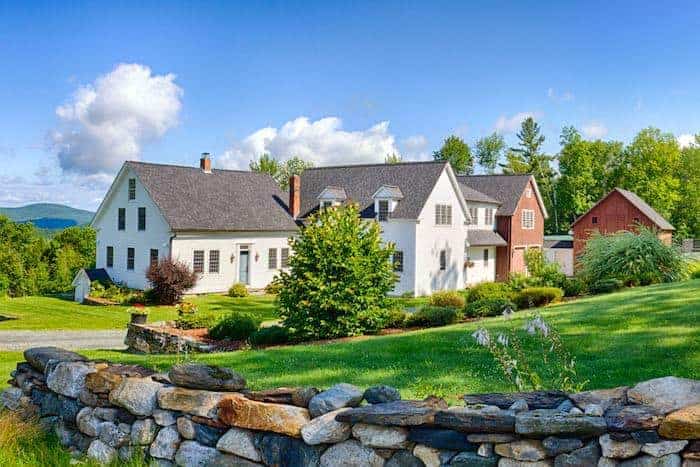
I love that you have taken the time to point out New Englander style. I recently moved to the East coast of Florida and have been trying to make my home reflect my Rhodesia Island and Massachusetts roots. The entire house is painted white and has hardwood floors throughout. I now plan to add bead board to several walls with a shelf on top as the walls are over 8 feet high. Wondering if I should paint the walls above the shelf in deep navy or sage green. Thoughts?
I grew up in Ma/NH and you hit the nail on the head for me. Thanks for putting my style into perspective!
I’m so glad it was helpful, Carrie! :)
This is such a lovely post. I live in New England in NSW Australia but it is nothing like your New England. I love the serenity and the WARMTH of the house. I feel cosy and relaxed just looking at it. Thank you for giving us a place to rest our eyes and mind
I love this! I’ve found so many beautiful decor ideas on Pinterest etc. but not much that I feel like I can connect to. I’m fairly new to owning a home, new to decorating, and new to this page and this post makes so much sense to me. I was born and raised in Massachusetts and live in an 100+ year old farmhouse about 30 min outside of Boston. It’s definitely not a rural community but my home has many of the New England Farmhouse charactistics that you mentioned including close neighbors and what’s left of an old stonewall in the backyard. I’ve had such a hard time figuring out how to decorate, and even what paint colors to choose because I’ve had a hard time figuring out my style. When I think of “New England style” it sounds stuffy to me and makes me think of black painted rocking chairs and cranberries, but so many other ideas feel inauthentic. This is so helpful!
I enjoyed your insight into design styles. I am moving back to my home state of Delaware and need to decide what I should keep. Do you think queen anne furniture will ever come back or should I just let it go? At the age of 65 I need less furniture to up keep but still need good quality. I used to enjoy antiques too but find they were pieces to look at and they offered little comfort. I would appreciate your thoughts.
I honestly think that if you love the pieces, it doesn’t matter if they are in style or not! I personally mix a lot of styles without regard to trends. :)
Hello, this is a beautiful blog! I found it as we are looking for a new color to paint the exterior of our home. I live in New Jersey, but love New England, especially the fresh, coastal style from that area. Our home is currently somewhere between light-medium gray with white trim and an espresso-colored wood door. Our neighbors, who have always loved our home and have copied many elements from our porch to our landscaping, just painted their home the same color as ours! While it’s flattering (not really!), we feel it’s time to change our exterior as it has not been painted since we moved in 8 years ago and maybe for a few years prior to that. We are thinking about a not-so-boring neutral like taupe. What do you think? My goal is to bring some New England to New Jersey! I also plan to replace our boxwood bushes with hydrangeas.
Visited New England and Cape Cod a few years ago and still long to return, such a beautiful part of the country. Thanks for the great post, brings back all I loved while we were there!
I am so excited to find your blog. I love,love New England. I am visiting Portsmouth this fall.
Hello Nina!
As a fellow resident of NH (Rye) I’m am so glad to have found your blog. Most of the blogs I find are from down south, which is great, but it isn’t New England! I look forward to reading your weekly newsletter
Thank you for the tips. I really love the style and I’m thinking of incorporating it into my home decor. Love it!
Great post! New England style is my inspiration as well. Beautifully written :)